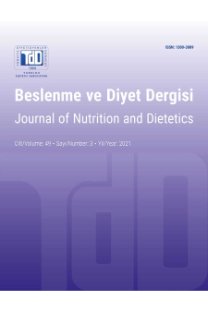Tip 1 Diyabetli Çocuk ve Adölesanların Diyet Kalitesi, Diyet Asit Yükü ve Glisemik Kontrol ile İlişkisi
Diet Quality, Dietary Acid Load and Their Relationship with Glycemic Control in Children and Adolescents with Type 1 Diabetes
___
- 1. Smart CE, Annan F, Bruno LPC, Higgins LA, Acerini CL. Nutritional management in children and adolescents with diabetes. Pediatr Diabetes. 2014;15(20):135-53.
- 2. Nansel TR, Haynie DL, Lipsky LM, Laffel LMB, Mehta SN. Multiple indicators of poor diet quality in children and adolescents with type 1 diabetes are associated with higher body mass index percentile but not glycemic control. J Acad Nutr Diet. 2012;112(11):1728-35.
- 3. Guerrero MLP, Pérez-Rodríguez F. Diet quality indices for nutrition assessment: types and applications. In: Chávarri Hueda M, editor. Functional food - Improve health through adequate food. London: InTech; 2017. p.282-308.
- 4. USDA. Profiling Food Consumption in America. Agricultural Fact Book. Washington: United States Department of Agriculture; 2001. p.13-22.
- 5. Williams RS, Kozan P, Samocha-Bonet D. The role of dietary acid load and mild metabolic acidosis in insulin resistance in humans. Biochimie. 2016;124:171-7.
- 6. Rodrigues Neto Angéloco L, Arces de Souza GC, Almeida Romão E, Garcia Chiarello P. Alkaline diet and metabolic acidosis: practical approaches to the nutritional management of chronic kidney disease. J Ren Nutr. 2018;28(3):215-20.
- 7. Alexy U, Kersting M, Remer T. Potential renal acid load in the diet of children and adolescents: Impact of food groups, age and time trends. Public Health Nutr. 2008;11(3):300-6.
- 8. Akter S, Eguchi M, Kuwahara K, Kochi T, Ito R, Kurotani K, et al. High dietary acid load is associated with insulin resistance: The Furukawa Nutrition and Health Study. Clin Nutr. 2016;35(2):453-9.
- 9. Banerjee T, Crews DC, Wesson DE, Tilea AM, Saran R, Ríos-Burrows N, et al. High dietary acid load predicts ESRD among adults with CKD. J Am Soc Nephrol. 2015;26(7):1693-700.
- 10. Schwalfenberg GK. The alkaline diet: Is there evidence that an alkaline pH diet benefits health? J Environ Public Health. 2012;2012(6):1-7.
- 11. Nansel TR, Lipsky LM, Liu A. Greater diet quality is associated with more optimal glycemic control in a longitudinal study of youth with type 1 diabetes. Am J Clin Nutr. 2016;104(1):81-7.
- 12. Mehta SN, Volkening LK, Quinn N, Laffel LMB. Intensively managed young children with type 1 diabetes consume high-fat, low-fiber diets similar to age-matched controls. Nutr Res. 2014;34(5):428-35.
- 13. Pekcan G. Beslenme durumunun saptanması. Baysal A, Aksoy M, Besler T, Bozkurt N, Keçecioğlu S, Mercanlıgil S, ve ark. editörler. Diyet El Kitabı. 7. baskı. Ankara:Hatiboğlu Yayınevi; 2013. s.67-142.
- 14. World Health Organization. Growth reference 5-19 years. 2007. Available at: http://www.who.int/growthref/ tools/en/ Accessed December 23, 2019.
- 15. Rakıcıoğlu, N, Acar Tek, N, Ayaz, A, Pekcan G. Yemek ve Besin Fotoğraf Kataloğu, Ölçü ve Miktarlar. 2. Baskı. İstanbul:Ata Ofset Matbaacılık; 2008. 132 s.
- 16. Beslenme Bilgi Sistemi - BeBiS, Versiyon 8; 2017, Istanbul.
- 17. Miller PE, Mitchell DC, Harala PL, Pettit JM, Smiciklas Wright H, Hartman TJ. Development and evaluation of a method for calculating the Healthy Eating Index-2005 using the Nutrition Data System for Research. Public Health Nutr. 2011;14(2):306-13.
- 18. Krebs-Smith SM, Pannucci TRE, Subar AF, Kirkpatrick SI, Lerman JL, Tooze JA, et al. Update of the Healthy Eating Index: HEI-2015. J Acad Nutr Diet. 2018;118(9):1591-602.
- 19. T.C. Sağlık Bakanlığı. Türkiye Beslenme Rehberi (TÜBER). Sağlık Bakanlığı Yayınları, Ankara, 2015. 288 s.
- 20. Remer T, Dimitriou T, Manz F. Dietary potential renal acid load and renal net acid excretion in healthy, free-living children and adolescents. Am J Clin Nutr. 2003;77(5):1255-60.
- 21. Frassetto LA, Todd KM, Morris RC, Sebastian A. Estimation of net endogenous noncarbonic acid production in humans from diet potassium and protein contents. Am J Clin Nutr. 1998;68(3):576-83.
- 22. Poupin N, Calvez J, Lassale C, Chesneau C, Tomé D. Impact of the diet on net endogenous acid production and acid-base balance. Clin Nutr. 2012;31(3):313-21.
- 23. Remer T, Manz F. Estimation of the renal net acid excretion by adults consuming diets containing variable amounts of protein. Am J Clin Nutr. 1994;59(6):1356-61.
- 24. Echouffo-Tcheugui JB, Ahima RS. Does diet quality or nutrient quantity contribute more to health? J Clin Invest. 2019;129(10):3969-70.
- 25. Nansel TR, Lipsky LM, Liu A, Laffel LMB, Mehta SN. Contextual factors are associated with diet quality in youth with type 1 diabetes mellitus. J Acad Nutr Diet. 2014;114(8):1223-9.
- 26. Rovner AJ, Nansel TR. Are children with type 1 diabetes consuming a healthful diet? Diabetes Educ. 2009;35(1):97-107.
- 27. McNaughton SA, Ball K, Crawford D, Mishra GD. An index of diet and eating patterns Is a valid measure of diet Quality in an Australian Population. J Nutr. 2008;138(1):86-93.
- 28. Woodruff SJ, Hanning RM. Development and implications of a revised Canadian Healthy Eating Index (HEIC-2009). Public Health Nutr. 2010;13(6):820-5.
- 29. Sherwani SI, Khan HA, Ekhzaimy A, Masood A, Sakharkar MK. Significance of HbA1c test in diagnosis and prognosis of diabetic patients. Biomark Insights. 2016;11:95-104.
- 30. Wiltshire EJ, Hirte C, Couper JJ. Dietary fats do not contribute to hyperlipidemia in children and adolescents with type 1 diabetes. Diabetes Care. 2003;26(5):1356-61.
- ISSN: 1300-3089
- Yayın Aralığı: 3
- Başlangıç: 1972
- Yayıncı: Türkiye Diyestisyenler Derneği
Yeni Koronavirüs (SARS-CoV-2/COVID-19) Pandemisi Sırasında Beslenme Tedavisi ve Önemi
Mücahit MUSLU, Dilek ÖZÖELİK ERSÜ
Can YALÇIN, SEZEN YILMAZ SARIALTIN, Mahmoud ABUDAYYAK, Engin YENİLMEZ
Yasemin KARAAĞAÇ, Hülya YARDIMCI
Hemodiyaliz Hastalarının Demografik Özelliklerine Göre Beslenme Durumlarının Değerlendirilmesi
Kübra Damla EKENCİ, Perim F. TÜRKER, Aydan ERCAN
Annelere Verilen Eğitimin Tamamlayıcı Beslenme Üzerine Etkisi
Gizem AYTEKİN ŞAHİN, Neşe KAYA, Meda KONDOLOT
Aralıklı Açlık Diyetleri ve Düşük Karbonhidratlı Diyetlerin Obezite Tedavisindeki Etkisi
Gökçe Sueda AYDOĞDU, Gamze AKBULUT
Tuba USTAOĞLU, Nilüfer TEK, Abdullah Emre YILDIRIM
COVID-19 Salgını: Diyetisyenlerin Rolü ve Rehberler
Romatoid Artritli Kadın Hastalarda Beslenme Durumunun Değerlendirilmesi
